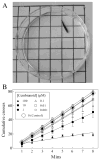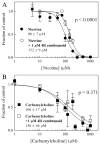A cembranoid from tobacco prevents the expression of nicotine-induced withdrawal behavior in planarian worms - PubMed (original) (raw)
A cembranoid from tobacco prevents the expression of nicotine-induced withdrawal behavior in planarian worms
Oné R Pagán et al. Eur J Pharmacol. 2009.
Abstract
Using an adaptation of published behavioral protocols, we determined that acute exposure to the cholinergic compounds nicotine and carbamylcholine decreased planarian motility in a concentration-dependent manner. A tobacco cembranoid (1S,2E,4R,6R,7E,11E)-cembra-2,7,11-triene-4,6-diol (4R-cembranoid), also decreased planarian motility. Experiments in the presence of 1 microM 4R-cembranoid did increase the IC50 for nicotine- but not carbamylcholine-induced decrease in planarian motility. When planarians were exposed for 24 h to either nicotine or carbamylcholine at concentrations near their respective IC50 values and then transferred to plain media, nicotine-exposed, but not carbamylcholine- or cembranoid-exposed worms displayed withdrawal-like distress behaviors. In experiments where planarians were pre-exposed to 100 microM nicotine for 24 h in the presence of 1 microM 4R-cembranoid, the withdrawal-like effects were significantly reduced. These results indicate that the 4R-cembranoid might have valuable applications for tobacco abuse research. This experimental approach using planarians is useful for the initial screening of compounds relevant to drug abuse and dependence.
Conflict of interest statement
Statement of potential conflict of interest
V.A.E. and O.R.P. are co-discoverers on two cembranoid-related patents: US 6,204,289.
B1 — “Cembranoid Inhibitors of Nicotinic Acetylcholine Receptors” and US 6,489,357 B1 — “Tobacco Cembranoids Block the Expression of Behavioral Sensitization to Nicotine and Inhibit Neuronal Acetylcholine Receptors”.
Figures
Fig. 1
Compounds used in this work. 4R cembranoid (1S,2E,4R,6R,7E,11E-cembra-2,7,11-triene-4,6-diol); (−) nicotine (3-(1-methylpyrrolidin-2-yl)pyridine) and carbamylcholine (2-carbamoyloxyethyl-trimethylammonium).
Fig. 2
A. Motility assay experimental setup (square size=1 cm2, see text). B. Effect of 4R-cembranoid in planarian motility. The data points were fit to a linear equation to generate the plots. Each line represents the average of experiments done with 4–10 worms. Similar plots were obtained for nicotine and carbamylcholine (data not shown). Error bars represent the standard error of the mean.
Fig. 3
Dose–response curves showing the effect of the experimental compounds on planarian motility, based on linear plots like Fig. 2B. Each data point represents the average of 4–10 worms. The lines and the IC50 values (μM±SEM) were generated by fitting the data to Eq. (1). Error bars represent the standard error of the mean.
Fig. 4
The presence of 1 μM 4R-cembranoid significantly increases the IC50 of nicotine, but not of carbamylcholine to induce motility decrease in planarians. A. Nicotine. B. Carbamylcholine. The lines and the IC50 s (μM±SEM) were generated using Eq. (1). The _p_-values were obtained through an _F_-test. Each data point represents the average of 3–10 worms. Error bars represent the standard error of the mean.
Fig. 5
Nicotine (100 μM, closed symbols), but not carbamylcholine (150 μM, open symbols), induce withdrawal-like behaviors in planarians, as indicated (see methods). Each symbol is the average of three experiments. Error bars are the standard error of the mean. _p_-values (_F_-test) are indicated in the figure.
Fig. 6
The “Scrunching/Squirming” behavior does not follow a linear pattern (see text). Nicotine (100 μM, closed symbols), carbamylcholine (150 μM, open symbols). The two data sets are significantly different from each other (p<0.05; two-way ANOVA). Each symbol is the average of three experiments. Error bars are the standard error of the mean.
Fig. 7
Nicotine (100 μM, closed symbols), but not nicotine+4R-cembranoid (100 and 1 μM respectively, open symbols), induce withdrawal-like behaviors in planarians, as indicated (see methods). Each symbol is the average of three experiments. Error bars are the standard error of the mean. _p_-values (_F_-test) are indicated in the figure.
Fig. 8
Nicotine (100 μM, closed symbols), but not nicotine+4R-cembranoid (100 and 1 μM respectively, open symbols), induce the “Scrunching/Squirming” behavior (see methods). The two data sets are significantly different from each other (p<0.001; two-way ANOVA). Each symbol is the average of three experiments. Error bars are the standard error of the mean.
Similar articles
- Parthenolide prevents the expression of cocaine-induced withdrawal behavior in planarians.
Rowlands AL, Pagán OR. Rowlands AL, et al. Eur J Pharmacol. 2008 Mar 31;583(1):170-2. doi: 10.1016/j.ejphar.2008.01.012. Epub 2008 Jan 26. Eur J Pharmacol. 2008. PMID: 18275955 - Nicotine behavioral pharmacology: clues from planarians.
Rawls SM, Patil T, Tallarida CS, Baron S, Kim M, Song K, Ward S, Raffa RB. Rawls SM, et al. Drug Alcohol Depend. 2011 Nov 1;118(2-3):274-9. doi: 10.1016/j.drugalcdep.2011.04.001. Epub 2011 May 6. Drug Alcohol Depend. 2011. PMID: 21530106 Free PMC article. - 4R-cembranoid protects against diisopropylfluorophosphate-mediated neurodegeneration.
Ferchmin PA, Andino M, Reyes Salaman R, Alves J, Velez-Roman J, Cuadrado B, Carrasco M, Torres-Rivera W, Segarra A, Martins AH, Lee JE, Eterovic VA. Ferchmin PA, et al. Neurotoxicology. 2014 Sep;44:80-90. doi: 10.1016/j.neuro.2014.06.001. Epub 2014 Jun 10. Neurotoxicology. 2014. PMID: 24928201 Free PMC article. - A Review on Bioactivities of Tobacco Cembranoid Diterpenes.
Yan N, Du Y, Liu X, Zhang H, Liu Y, Zhang Z. Yan N, et al. Biomolecules. 2019 Jan 16;9(1):30. doi: 10.3390/biom9010030. Biomolecules. 2019. PMID: 30654586 Free PMC article. Review. - Structural Modifications and Biological Activities of Natural α- and β-Cembrenediol: A Comprehensive Review.
Xu K, Du X, Ren X, Li X, Li H, Fu X, Wei X. Xu K, et al. Pharmaceuticals (Basel). 2022 May 13;15(5):601. doi: 10.3390/ph15050601. Pharmaceuticals (Basel). 2022. PMID: 35631427 Free PMC article. Review.
Cited by
- Effects of Fe3+ on Acute Toxicity and Regeneration of Planarian (Dugesia japonica) at Different Temperatures.
Ding X, Song L, Han Y, Wang Y, Tang X, Cui G, Xu Z. Ding X, et al. Biomed Res Int. 2019 Aug 22;2019:8591631. doi: 10.1155/2019/8591631. eCollection 2019. Biomed Res Int. 2019. PMID: 31534964 Free PMC article. - Levamisole and cocaine synergism: a prevalent adulterant enhances cocaine's action in vivo.
Tallarida CS, Egan E, Alejo GD, Raffa R, Tallarida RJ, Rawls SM. Tallarida CS, et al. Neuropharmacology. 2014 Apr;79:590-5. doi: 10.1016/j.neuropharm.2014.01.002. Epub 2014 Jan 15. Neuropharmacology. 2014. PMID: 24440755 Free PMC article. - Nicotine-induced C-shape movements in planarians are reduced by antinociceptive drugs: Implications for pain in planarian paroxysm etiology?
Kim A, Rawls SM. Kim A, et al. Brain Res. 2022 Mar 1;1778:147770. doi: 10.1016/j.brainres.2021.147770. Epub 2021 Dec 31. Brain Res. 2022. PMID: 34979130 Free PMC article. - Stereochemistry and neuropharmacology of a 'bath salt' cathinone: S-enantiomer of mephedrone reduces cocaine-induced reward and withdrawal in invertebrates.
Vouga A, Gregg RA, Haidery M, Ramnath A, Al-Hassani HK, Tallarida CS, Grizzanti D, Raffa RB, Smith GR, Reitz AB, Rawls SM. Vouga A, et al. Neuropharmacology. 2015 Apr;91:109-16. doi: 10.1016/j.neuropharm.2014.11.010. Epub 2014 Dec 9. Neuropharmacology. 2015. PMID: 25496724 Free PMC article. - Minimal structural requirements of alkyl γ-lactones capable of antagonizing the cocaine-induced motility decrease in planarians.
Baker D, Deats S, Boor P, Pruitt J, Pagán OR. Baker D, et al. Pharmacol Biochem Behav. 2011 Nov;100(1):174-9. doi: 10.1016/j.pbb.2011.08.013. Epub 2011 Aug 22. Pharmacol Biochem Behav. 2011. PMID: 21878350 Free PMC article.
References
- Best JB, Morita M. Toxicology of planarians. Hydrobiologia. 1991;227:375–383.
- Brenner ED, Stevenson DW, Twigg RW. Cycads: evolutionary innovations and the role of plant-derived neurotoxins. Trends Plant Sci. 2003;8:446–452. - PubMed
- Buttarelli FR, Pontieri FE, Margotta V, Palladini G. Acetylcholine/dopamine interaction in planaria. Comp Biochem Physiol C. 2000;125:225–231. - PubMed
- Buttarelli FR, Pontieri FE, Margotta V, Palladini G. Cannabinoid-induced stimulation of motor activity in planaria through an opioid receptor-mediated mechanism. Prog Neuro-Psychopharmacol Biol Psychiatry. 2002;26:65–68. - PubMed
- Cebrià F, Kudome T, Nakazawa M, Mineta K, Ikeo K, Gojobori T, Agata K. The expression of neural-specific genes reveals the structural and molecular complexity of the planarian central nervous system. Mech Dev. 2002;116:199–204. - PubMed
Publication types
MeSH terms
Substances
LinkOut - more resources
Full Text Sources







